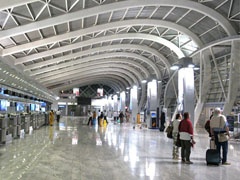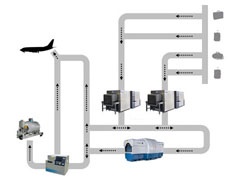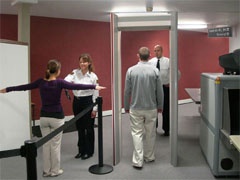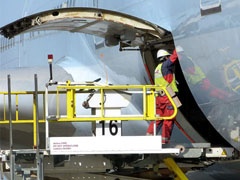 Most airports have numerous screening checkpoints situated in different areas of its facility. Passenger, cabin baggage, hold baggage, cargo, and non-passenger screening are typical checkpoints.
Most airports have numerous screening checkpoints situated in different areas of its facility. Passenger, cabin baggage, hold baggage, cargo, and non-passenger screening are typical checkpoints.
These airport checkpoints screen and process people, belongings, and cargo nonstop to prevent the entry of prohibited and dangerous items. Let’s briefly run through the different types of security screening checkpoints typically found at airports.
Hold Baggage Screening (HBS)
 What is screened? Passengers’ checked baggage handed over to the airlines
What is screened? Passengers’ checked baggage handed over to the airlines- Methods: Computed Tomography (CT) system, explosives detection system (EDS), X-ray system, explosives trace detection (ETD), physical search
- Typical Throughput: Liquids, aerosols, and gels (LAGs) of any amount, clothes, shoes, accessories, electronics, toiletries, food, souvenirs
- Allowable Items: Sharp objects (knives, box cutters, scissors), firearms, ammunition, sporting equipment, alcohol, self defense sprays, martial arts weapons, tools
- Prohibited Items: Loose lithium batteries, e-cigarettes and vaping devices, realistic replicas of explosives, safety matches, flares, chlorine and liquid bleach
Passenger Pre-Board Screening
 Who is screened? Passengers entering the secure area of the airport
Who is screened? Passengers entering the secure area of the airport- Methods: Walk-through metal detector, hand-held metal detector, full-body scanner, partial or full pat-down, explosives trace detection
Cabin Baggage Screening (CBS)
- What is screened? Passengers’ carry-on baggage and personal belongings
- Methods: X-ray system, explosives trace detection, physical search
- Typical Throughput: Clothes, shoes, accessories, jewelry, cell phones, laptops, tablets, eReaders, toiletries, medication, food/snacks, literature
- Allowable Items: E-cigarettes and vaping devices, lighters, ice skates and rollerblades, disposable razors, undeveloped camera film
- Prohibited Items: Firearms, ammunition, sporting equipment (baseball bats, golf clubs, ski poles), LAGs over a certain amount, fireworks, hoverboards, gel candles
Cargo Screening
- What is screened? Cargo and packages tendered for air transport
- Methods: X-ray system, explosives trace detection, explosives detection system, electronic metal detection (EMD) system, canine search, physical search
- Prohibited or Restricted Items: Lithium batteries, ivory, fireworks, hazardous materials (HazMat)
Non-Passenger Screening
-
 Who is screened? Airport employees, airline staff, and contracted workers accessing restricted areas of the airport along with their personal items. Includes flight and cabin crews, baggage handlers, maintenance personnel, customer service representatives, caterers, etc.
Who is screened? Airport employees, airline staff, and contracted workers accessing restricted areas of the airport along with their personal items. Includes flight and cabin crews, baggage handlers, maintenance personnel, customer service representatives, caterers, etc. - Methods: X-ray system, walk-through metal detector, hand-held metal detector, full-body scanner, partial or full pat-down, explosives trace detection, physical search
Conclusion
Airport operators match each individual checkpoint with the best suited screening methods and technology available. As technology advances, we will see changes to the typical checkpoint. Some airports are experimenting with 3D X-ray technology to provide a better, more secure screening process. Others are deploying liquid and bottle scanners and/or shoe scanners. What will the next screening technology be?
